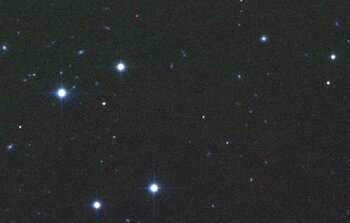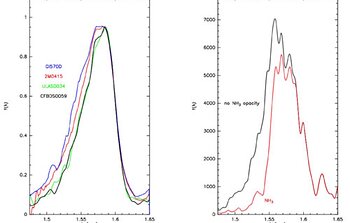Ammonia Found in Atmosphere of Coolest Brown Dwarf
April 10, 2008

Near-infrared observations taken at Gemini North have detected ammonia in the spectra of the coolest brown dwarf ever discovered. This is the first time such a finding has been made in near-infrared spectra of a sub-stellar object other than a planet.
The brown dwarf (an object with a mass between that of a star and planet) is known as CFBDS J005910.83-011401.3 (shortened as CFBDS0059) and has an oven-like temperature of only about 350º C and a mass between 15-30 times that of Jupiter. The object is about 40 light-years from us and is located in the constellation Cetus near the boundary with Pisces. It is an unusual isolated object not orbiting another star, but if it were, it would be more difficult to study due to the competing light of the companion star.
CFBDS0059 might be a prototype of a new proposed class of brown dwarfs called Y dwarfs that have eluded detection thus far by researchers. This discovery marks the first time a BD has been found that is cold enough to show spectroscopic features that were not found in Gl229b, the prototype of cold brown dwarfs discovered in 1995. CFBDS0059 will provide constraints to models of cool BDs and extrasolar planets. This discovery also shed light on the nature of the previous record holder of the coldest brown dwarf title : ULAS0034 discovered only a few months before CFBDS0059. Although not recognized as such at the time of its discovery, this object also displays the telltale signature of ammonia in its spectra. Models indicate that CFBDS0059 is about 50 C colder and slightly more massive than ULAS0034.
The Gemini observations with the Near Infrared Imager (NIRI) both confirmed the object’s low temperature and the presence of ammonia in its atmosphere. Ammonia is a key identifier in classifying this object in the middle ground between a star and a planet. Until now, only planets have shown ammonia signatures in their near-infrared spectra.
The discovery of the object was made by an international team led by French and Canadian astronomers who used the Canada-France-Hawai‘i Telescope (CFHT) and the ESO/New Technology Telescope in Chile to make the initial identification of the object. The Gemini observations were made in queue mode on July 30, 2007.
Links
- The paper will appear in Astronomy and Astrophysics and can be downloaded at arXiv.
- An electronic version of the Astronomy and Astrophysics press release about this coolest brown dwarf


